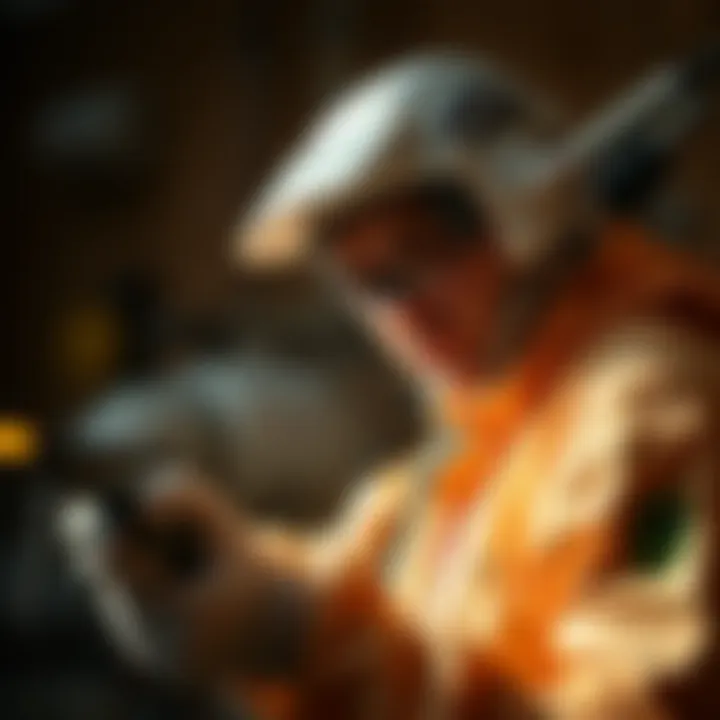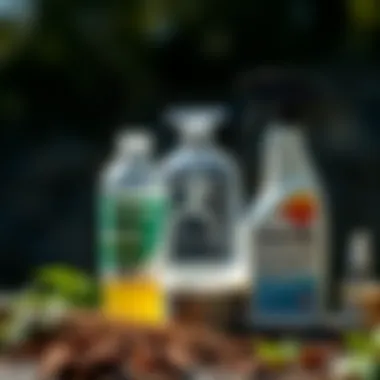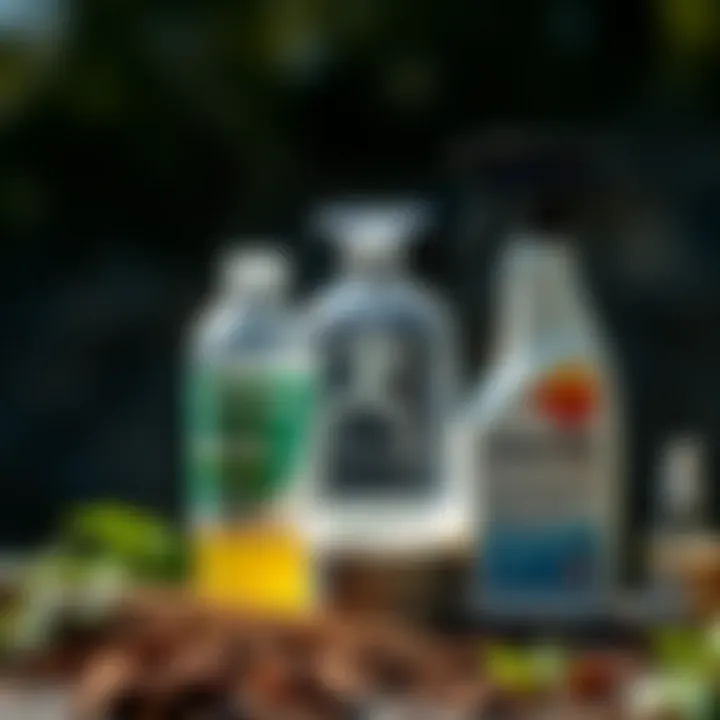Top Insecticides for Effective Pest Control


Intro
Pests, whether in your home or garden, can quickly turn a peaceful environment into a battleground. They sneak in unnoticed, disrupt the tranquility, and can even pose health risks. Understanding both the nature of these pests and the effective means to control them is crucial for any homeowner. In this article, we delve deep into the best insecticides suitable for indoor and outdoor use, offering strategies to manage these unwelcome guests while keeping safety and environmental concerns in mind.
We will provide insights into various insecticides, including their chemical composition, effectiveness, and safety profile. By the end of this piece, you’ll be equipped with the knowledge to make informed decisions on pest control that marry efficacy with ecological responsibility.
Let’s get started by understanding the first element of pest management—recognizing pests for what they are and why identifying them is essential.
Understanding Pests
Definition of Pests
Pests are organisms capable of causing damage or discomfort to humans, their property, or their food sources. These can range from insects like ants and cockroaches to rodents and even certain plants classified as weeds. Each pest poses its own unique set of challenges and requires a tailored approach to management. For example, while an ant infestation might warrant a different strategy than managing carpenter bees, both issues must be addressed promptly to prevent larger problems down the line.
Importance of Pest Identification
Identifying pests accurately is one of the first steps in effective pest control. Without proper identification, you might end up applying the wrong treatment, wasting both time and resources. Moreover, some pests carry diseases or can cause significant property damage if not handled correctly.
Consider the following points:
- Health Risks: Some pests, like ticks or mosquitoes, can transmit diseases. Understanding what you're dealing with can help mitigate risks to your family and pets.
- Targeted Treatment: Different pests require different methods or products for eradication. A targeted approach is often more effective and less harmful to non-target organisms.
- Ecosystem Impact: Not all insects are harmful; some are beneficial and crucial for pollination or as part of the food web. Knowing the difference can help in making eco-conscious decisions.
"By taking the time to identify pests correctly, you lay the groundwork for effective management strategies that are mindful of safety and the environment."
In essence, understanding pests sets the stage for all subsequent pest management efforts. As we delve further, we will discuss preventative techniques that can help minimize the risk of infestations in the first place.
Prelude to Insecticides
The realm of pest control hinges on a fundamental understanding of insecticides, their roles, and their varied applications. Pest issues, whether in urban homes or rural landscapes, demand attention. Here, we explore not only the types and functions of insecticides but also their significance in maintaining our spaces and food sources. By diving deep into this topic, homeowners can be equipped with the knowledge needed for effective pest management, striking a balance between efficacy and safety.
Definition and Function of Insecticides
Insecticides are specialized substances designed to target and control insect populations. These chemicals can either disrupt an insect's nervous system or interfere with their life cycle functions. For instance, some may cause paralysis, while others can simply cause reproductive failure over time.
A common classification breaks insecticides into two main categories: contact and systemic.
- Contact insecticides affect insects upon direct contact, acting swiftly to eliminate visible threats.
- Systemic insecticides, on the other hand, are absorbed by plants and affect pests that consume parts of them. This duality showcases the crucial nature of choosing the right insecticide in the right context.
Understanding the basic functions behind these chemicals allows one to identify the right tool for the job, ensuring that pest problems are effectively managed without unnecessary environmental or personal health risks.
Importance of Pest Control
Pest control is pivotal not just for convenience, but for health and safety. Pests like mosquitoes, rodents, and various insects can carry diseases, leading to considerable health risks. With an effective pest management strategy, one can mitigate these risks, thus protecting families and pets.
Moreover, pests can cause significant damage to property. Termites, for instance, can compromise the structural integrity of a home if left unchecked, quickly turning a small issue into an expensive repair job.
Consider the following benefits of a robust pest control approach:
- Prevention of Disease: Many pests are known carriers of harmful pathogens. Controlling these populations minimizes the chances of disease spread.
- Protection of Property: Regular monitoring and appropriate pest management can save homeowners substantial future costs related to damage.
- Improved Quality of Life: A pest-free environment contributes to overall well-being and peace of mind.
In summary, understanding the ins and outs of insecticides and their role in pest control emphasizes the necessity of informed choices. This article aims to provide a comprehensive guide to navigating the dynamic landscape of insecticides, equipping readers with the knowledge to make wise pest control decisions.
Types of Insecticides
Understanding the types of insecticides is essential for anyone looking to control pests effectively, whether inside a home or out in the garden. Each type serves its purpose, and selecting the right kind can make all the difference in ensuring successful pest management. The variety of insecticides available allows homeowners to tailor their approach based on specific situations, preferences for safety, and environmental considerations.
When deciding on an insecticide, it’s important to factor in various elements such as the specific pests being targeted, the effectiveness you expect, and any safety concerns you might have, especially if children or pets are around. Given the continuous evolution of pest control methods, having knowledge of these different types will aid in making informed decisions.
Synthetic Insecticides
Synthetic insecticides are man-made chemicals designed specifically to tackle a wide range of pests. These agents are effective at managing infestations and are widely used in both residential and commercial contexts. Their capability to deliver strong results in a short timeframe has made them popular, but there's a duality in their usage that deserves careful consideration.
- Advantages:
- Disadvantages:
- Rapid action on pests, often resulting in immediate control.
- Broad-spectrum activity, meaning they can kill multiple types of insects.
- Often more cost-effective than organic options.


- Potential harm to beneficial insects and the environment.
- Possible health risks associated with chemical exposure for humans and pets.
Examples of common synthetic insecticides include pyrethroids and neonicotinoids. They disrupt the nervous system of insects and can effectively eliminate various pesky invaders, yet, caution must be taken to minimize risk to non-target organisms. Therefore, it's crucial to use these products responsibly and follow instructions for application.
Organic Insecticides
Organic insecticides offer a more nature-friendly approach to pest control. Made from natural sources, these products are gaining traction among homeowners eager to eliminate pests without resorting to hazardous chemicals. They can be particularly appealing for those with gardens or areas frequented by children and pets.
- Advantages:
- Generally safer for non-target species, including beneficial insects and humans.
- Often decompose naturally, reducing environmental impact.
- Many organic options can be used in home gardening without long waiting periods before harvest.
Some well-known organic insecticides include neem oil and insecticidal soap. These substances disrupt pests’ life cycles rather than killing them outright, making them an effective and sustainable choice for managing minor infestations. However, one must often apply organic products more frequently than their synthetic counterparts to achieve similar results.
Biopesticides
Biopesticides fall under the umbrella of eco-friendly options and leverage naturally occurring organisms or natural substances to control pests. These products are rising in popularity due to their specific target action and lower risk of harming the environment compared to traditional insecticides.
- Types of Biopesticides:
- Advantages:
- Considerations:
- Microbial pesticides: Incorporate microorganisms that deter pests, such as Bacillus thuringiensis.
- Plant-incorporated protectants: Use genetic material from bacteria or plants to create resistance in crops.
- High specificity means they target only certain pests without harming beneficial insects.
- Lower risk of developing resistance in pests.
- Efficacy can vary based on environmental conditions.
- May require specific conditions for optimal effectiveness, such as moisture and temperature.
Selecting the Right Insecticide
Choosing the right insecticide is not just a mere task; it’s an essential piece in the puzzle of effective pest control. With countless options flooding the market, understanding how to pick the most suitable insecticide becomes a crucial skill for homeowners and gardeners alike. A wrong choice can lead to ineffective pest management and potentially harmful consequences for both health and the environment.
The first consideration should be identifying the specific pest you’re dealing with. Different insects respond to different chemicals and handling methods. For example, the approach for dealing with termites differs significantly from that needed to combat ants or bedbugs. Discovering their weaknesses can change the game.
Moreover, the environmental impact is another key factor. Ensuring that your pest control methods are eco-friendly can prevent negative repercussions on your surroundings, pets, and family. This article will guide you in balancing efficacy and environmental responsibility.
Another critical aspect is safety. The risks associated with both indoor and outdoor applications shouldn’t be overlooked. Utilizing appropriate safety measures ensures not only your protection but also that of your loved ones and pets.
In essence, selecting the right insecticide is about making informed decisions based on careful assessment of pests, environmental considerations, and safety measures.
Assessing the Type of Pest
Identifying the pest at hand is like finding a needle in a haystack; yet it's necessary for effective control measures. Each pest—be it a cockroach hiding in the kitchen corners or aphids chewing on beloved roses—has unique characteristics. Knowing these will guide your choices.
For instance, common household pests include:
- Roaches: They thrive in moist environments, often the kitchen or bathroom.
- Bedbugs: These are elusive and often require targeted treatments.
- Termites: Usually hidden, they can cause massive damage if not addressed quickly.
- Garden pests: Such as beetles and caterpillars can not only harm plants but disrupt the ecosystem.
Evaluating Environmental Impact
When applying insecticides, it’s vital to think beyond the immediate issue of pest control. The usage of certain products can lead to broader environmental issues ranging from pollution to harmful side effects on beneficial insects.
Here are a few points to consider:
- Chemical runoff can severely affect nearby wildlife and waterways.
- Some insecticides are harmful to bees and other pollinators, which are crucial for a balanced ecosystem.
- Many chemical insecticides leave residues, which can linger long after application, impacting air and soil quality.
Taking the time to evaluate your choices can pave a pathway to safer pest control that contributes to a healthier environment.
Safety Considerations for Indoor Use
Indoor insecticide applications come with their own set of unique challenges. Since many individuals dwell in tight spaces, ensuring safety becomes paramount.
- Always read labels carefully and adhere to the recommended dosages.
- Ventilate the area before and after applying insecticides. Open windows and doors to allow fresh air to circulate.
- Store products properly and out of reach of children and pets. Safe storage can prevent accidental exposure.
- Consider using natural alternatives or less toxic products wherever possible. They can be effective with fewer safety concerns.
Safety Considerations for Outdoor Use
Applying insecticides outdoors requires extra caution as well, especially regarding your lawn, garden, and surrounding environment. Here are some important pointers:
- Pay attention to weather conditions. Avoid applying insecticides during windy days to minimize drift.
- Wear protective gear like gloves, masks, or goggles to prevent skin or respiratory exposure.
- Be aware of the local wildlife. Some insecticides can be harmful to birds, fish, and beneficial insects.
- Avoid applying near water bodies. Runoff can contribute to larger environmental issues impacting aquatic life.


When applying insecticides outdoors, the considerations are not just for your property but also for all organisms in the vicinity. Not taking the above precautions can lead to unforeseen consequences that impact both safety and health.
Best Indoor Insecticides
In the realm of pest control within the home, the use of effective indoor insecticides cannot be taken lightly. These products serve not only to rid spaces of unwanted pests but they also play a significant role in maintaining a healthy living environment. The presence of insects can lead to health issues, property damage, and overall discomfort in homes. Thus, understanding the options available for indoor pest management is critical.
Chemical Options
Chemical insecticides are often the first line of defense when dealing with persistent pest problems. These include a variety of compounds specifically engineered to target and eliminate pests efficiently. Pyrethroids, for instance, are a popular class of synthetic insecticides derived from natural sources. They are fast-acting, making them an attractive choice for immediate infestation concerns. Products containing Bifenthrin or Permethrin have shown excellent effectiveness against a range of insects like ants, cockroaches, and spiders.
However, it’s important to consider their application carefully. Using chemical insecticides requires precise adherence to instructions. For best results, indoors, it’s advisable to focus on cracks and crevices where insects often hide, as these areas are commonly overlooked. Before applying these products, make sure to read the labels for safety precautions, and always ventilate the space afterwards to avoid any adverse effects.
Natural Alternatives
For those who prefer a more eco-friendly approach, natural alternatives do exist. These options often use plant-based ingredients or essential oils that can deter or kill pests without the harsh chemicals associated with traditional insecticides. For example, diatomaceous earth is a powdery substance that disrupts the exoskeletons of insects, leading to dehydration and death. Similarly, essential oils such as peppermint oil and tea tree oil have insect-repelling properties and can be diffused throughout the home or mixed with water for spraying.
It’s worth noting, however, that while natural remedies may be less toxic, they can require more frequent application and may not always yield instant results. That being said, many homeowners appreciate the peace of mind that comes from using such products, knowing they aren’t introducing harsh chemicals into their living spaces.
Application Techniques
Regardless of the type of insecticide chosen, the method of application plays a pivotal role in its effectiveness. Here are some tips to ensure proper application:
- Target Hot Spots: Focus on areas where pests are most likely to enter or congregate, like doors, windows, and plumbing lines.
- Follow Dosage Instructions: Adhering to the recommended amounts is crucial. Overapplication can lead to unnecessary chemical buildup and health risks.
- Timing Matters: Applying insecticides during the evening when pests are most active can enhance effectiveness.
- Utilize Traps and Baits: Sometimes, combining chemical or natural insecticides with traps can provide an extra layer of control.
- Maintain Cleanliness: Regular housekeeping can significantly reduce pest presence, making insecticide use more effective.
By following these practices, homeowners can maximize the effectiveness of their chosen indoor insecticides, balancing their pest control needs with a commitment to safety and environmental responsibility.
"Effective pest control is as much about prevention as it is about eradication. A clean home is your best defense against unwanted invaders."
For further guidance on pest management strategies and resources, consider visiting EPA's website.
Best Outdoor Insecticides
When it comes to maintaining an inviting outdoor space, insect infestations can be a real thorn in your side. That’s why understanding the best outdoor insecticides is essential for every homeowner or gardener. Knowing which products to use can ensure your garden flourishes while keeping those unwanted pests at bay. The right outdoor insecticides can combat common nuisances like mosquitoes, ants, and aphids while minimizing harm to beneficial insects and the environment.
Effective Chemical Treatments
Chemical insecticides continue to be a powerful tool against outdoor pests. These products usually contain synthetic compounds designed to target specific insects effectively. Among the effective treatments, you’ll find brands like Cyfluthrin and Permethrin, which work quickly to eliminate pests. Their modes of action, often disrupting the nervous system of insects, make them formidable options in your pest control arsenal.
- Advantages of Chemical Treatments:
- Fast-acting: Works immediately upon contact.
- Broad-spectrum: Targets various types of pests effectively.
- Long-lasting effects: Some insecticides continue to work even after application.
However, it’s important to follow the directions closely, as misuse can lead to unintended consequences, including harm to beneficial insects and potential effects on local wildlife. Always remember to treat areas during times when beneficial insects are least active to maximize their safety.
Eco-friendly Solutions
For those opting for a more natural route, eco-friendly insecticides have come a long way. These formulations use natural ingredients or lower toxicity levels, making them safer for non-target insects, pets, and humans. Common options include neem oil, derived from the seeds of the neem tree, and various insecticidal soaps that suffocate pests without harsh chemicals.
- Benefits of Eco-friendly Solutions:
- Reduced environmental impact: Less harmful to the ecosystem.
- Safer for children and pets, making your outdoor space enjoyable for the whole family.
- Often sustainable: Many ingredients are renewable.
Always check for product labels that highlight effective ingredients, and remember that natural solutions might require more frequent applications to maintain effectiveness.
Preventive Measures
As they say, an ounce of prevention is worth a pound of cure. Adopting preventive measures can significantly reduce pest issues before they even begin. Simple changes in your garden setup or routine can keep pests from turning your outdoor haven into a battleground.
- Integrate these practices:
- Regularly clean debris: A tidy outdoor space lessens hiding spots for pests.
- Encourage predatory insects: Invite ladybugs and predatory wasps to help control pest populations naturally.
- Rotate plants: Changing the layout of your plants every season can confuse pests that are keen on returning to familiar favorites.
Implementing these preventive strategies ensures that you spend less time battling pests and more time enjoying your outdoor experience.
By combining effective chemical treatments with eco-friendly solutions and preventive measures, you create a robust strategy for pest control. Not only can you manage existing pest problems, but your efforts can also create a sustainable and welcoming environment for the long haul.
Application Safety and Techniques


When it comes to applying insecticides, safety and technique are paramount. One might think effective pest control can be a straightforward venture, but it can become quite complex if safety measures are overlooked. The need for protective strategies, proper methods of application, and procedures after application cannot be stressed enough. This section dives into these critical aspects, ensuring that both the user and the environment are protected while effectively managing pests.
Protective Gear
The first line of defense during any insecticide application is protective gear. This includes a combination of clothing and equipment designed to shield the skin and respiratory system from potential exposure to harmful chemicals. It’s easy to overlook the importance of wearing gloves, masks, goggles, and long-sleeve shirts during such tasks, but neglecting this can lead to significant health risks.
- Gloves: These keep your hands safe from skin irritations and harsh chemicals. Look for gloves made of nitrile or rubber, as these materials offer decent resistance to many insecticides.
- Masks: A mask helps protect the airways from inhaling toxic particles. A respirator rated for pesticide use provides added safety.
- Goggles: Protect your eyes from sprays or splashes, particularly if you are working in a confined or poorly ventilated area.
It's also wise to wear older clothes that you wouldn’t mind getting soiled and to tie back long hair to prevent contamination. By donning the right gear, you create an extra layer of assurance, ensuring your safety while battling those pesky intruders.
Proper Application Methods
Using the right application method is crucial for safe and effective pest management. It’s not merely about spraying the insecticide haphazardly; rather, it requires some thought and consideration. Let's break down a few proper techniques:
- Target the Area: Before applying the insecticide, assess the infestation zone. Focus on spots where pests are likely to gather, such as cracks, crevices, and corners. Avoid open areas to reduce wastage and minimize unintended harm to beneficial insects.
- Follow Instructions: Adhere strictly to the manufacturer's guidelines regarding dosage and application frequency. Using more than recommended doesn’t necessarily mean better results; in fact, it can pose risks to both health and the environment.
- Use Appropriate Tools: Depending on whether you're spraying, dusting, or using granules, ensure you’re employing the right tools for the job. For instance, a sprayer with adjustable nozzles can control the dispersal rate effectively.
By applying insecticides judiciously and utilizing proper methods, pest control becomes efficient without compromising safety.
Post-application Procedures
Once you've finished applying the insecticide, what happens next is equally important. It’s about implementing the right post-application procedures to ensure safety and efficacy. Here are the steps to consider:
- Ventilation: For indoor applications, open windows and doors to allow fresh air circulation. This helps to dissipate any lingering chemical vapors.
- Clean Up: Dispose of any leftover insecticide safely, following local regulations. Clean your equipment thoroughly to prevent cross-contamination on future uses.
- Monitoring: Keep an eye on the treated areas for any signs of reinfestation or adverse effects on plants, pets, or individuals in the vicinity.
Proper post-application practices help sustain safety while ensuring the insecticides work effectively over time.
By being diligent in safety protocols and application methods, you ensure a healthy home and environment while keeping pests at bay.
Long-term Pest Management Strategies
Long-term pest management strategies hold significant importance when it comes to effective and sustainable pest control. The main objective is to create a balanced ecosystem where pest populations are kept in check without relying heavily on chemical insecticides. This approach not only safeguards the immediate environment but also promotes a healthier habitat for future generations.
By focusing on sustainable practices, homeowners and pest management professionals can manage pests in a way that reduces the likelihood of resistance build-up among pest populations, decreasing the effectiveness of chemicals over time. A comprehensive understanding of long-term strategies is key, as they emphasize not just immediate solutions but effective prevention methods that ensure pests do not become a recurring problem.
Integrated Pest Management (IPM)
Integrated Pest Management (IPM) is an essential framework that holistically combines multiple methods to control pests while minimizing risks to people and the environment. It starts with thorough pest identification; understanding the specific pests in your area and their behaviors is crucial. This knowledge paves the way for tailored pest management plans that may include a mixture of biological, cultural, physical, and chemical strategies.
Among the various tactics employed in IPM, you might find:
- Biological Control: Introducing natural predators or parasites to target pest populations effectively. For instance, ladybugs can help control aphid infestations.
- Cultural Control: Adjusting farming practices, such as crop rotation or promoting plant diversity, helps to dissuade pests naturally.
- Monitoring and Thresholds: Regular assessments to determine pest levels allow for timely action before they escalate into larger infestations. This can be as simple as setting traps to gauge pest presence.
Implementing IPM strategies not only reduces reliance on chemical insecticides but also encourages a deeper connection with the environment. It's an approach that fosters a sense of responsibility while achieving effective pest control.
Cultural Practices for Prevention
Cultural practices serve as a proactive approach to prevent pest infestations from occurring in the first place. These practices involve modifying the environment or habitual practices to deter pests naturally. Several effective cultural practices include:
- Proper sanitation: Regularly cleaning areas where food is prepared or stored can help eliminate breeding grounds for pests.
- Water management: Ensuring proper drainage and avoiding standing water reduces the risks of mosquitoes and other water-related pests breeding near your home.
- Plant selection: Choosing pest-resistant plants for your garden can minimize the need for intervention. For example, some herbs like rosemary and lavender naturally repel certain insects.
- Mulching & Composting: Using organic mulch can control weeds while also suppressing certain insect populations.
These cultural practices require little investment and can bring about significant changes in pest management effectiveness. Homeowners can also cultivate a sense of stewardship over their surroundings by adopting these practices, leading to healthier living spaces and gardens. By putting these prevention strategies in place, the pest population is more manageable, and the environment remains in harmony with nature.
"An ounce of prevention is worth a pound of cure." - Benjamin Franklin.
In summary, integrating long-term pest management strategies, particularly through IPM and cultural practices, leads to a thoughtful approach in handling pest issues. Not only do these methods reduce the immediate need for chemical insecticides, but they also promote a sustainable future for pest management.
Culmination
In wrapping up our exploration of insecticides, it’s essential to underscore the critical role of these substances in maintaining a healthy living environment—both indoors and outdoors. Effective pest control is not just about getting rid of unwanted insects. It’s about striking the right balance between efficiency and environmental care. Every homeowner and gardener needs to know the ins and outs of the products they choose, ensuring they make informed decisions that align with their values and expectations.
Summing Up Effective Insecticide Use
When it comes to effective insecticide use, grasping the diverse range of options available is vital. Homeowners should not only consider the chemical makeup of the product but also its intended application. Here are the key takeaways:
- Understanding the Pest: Knowing the specific pests you’re targeting helps select the right product. For example, roaches may require different treatments than ants.
- Safety First: Always prioritize safety protocols. Using appropriate protective gear and carefully following application guidelines reduces risk and maximizes effectiveness.
- Eco-awareness: Opting for eco-friendly alternatives can significantly diminish adverse effects on beneficial insects and the broader environment. Choices like diatomaceous earth or neem oil exemplify how pest management can align with ecological mindfulness.
These elements collectively foster a more conscientious approach to pest control, allowing individuals to address infestations while keeping health and sustainability at the forefront.
Future Trends in Pest Control
Pest control methodologies are progressively evolving, driven by advances in technology and growing environmental consciousness. The future holds several promising trends that will shape how we approach pest management:
- Smart Technologies: Innovations such as app-based monitoring systems can alert homeowners of pest activity in real time, allowing for quicker responses.
- Targeted Solutions: Biopesticides are gaining traction due to their specificity—they target only harmful pests without disrupting beneficial populations.
- Sustainability: As environmental concerns heighten, there is a clear shift towards products that are less harmful to the ecosystem. This includes further research into natural ingredients that can effectively manage pests.
- Community Engagement: Collaborative efforts in neighborhoods can benefit pest control strategies. Community awareness and support can foster environments hostile to pests.



